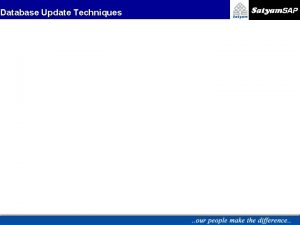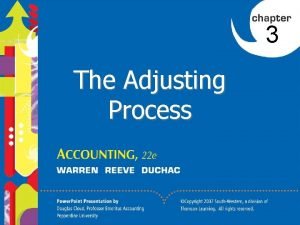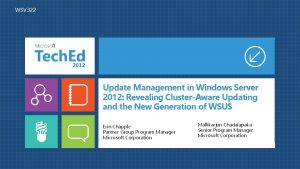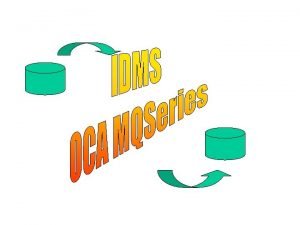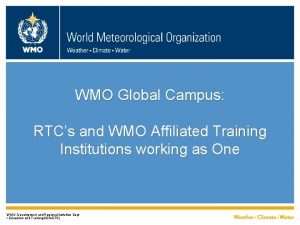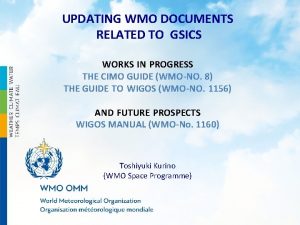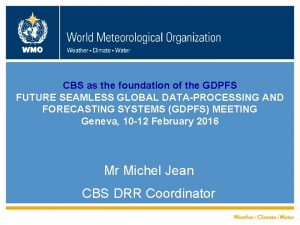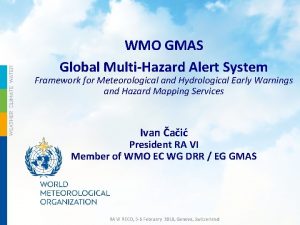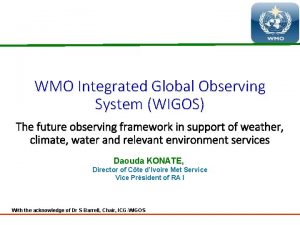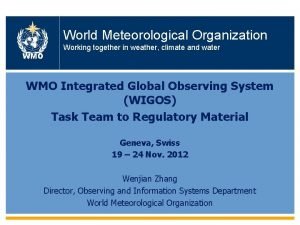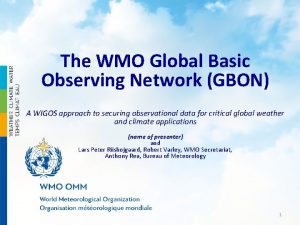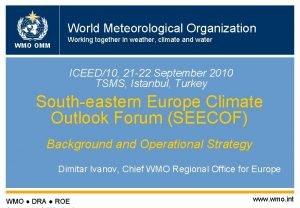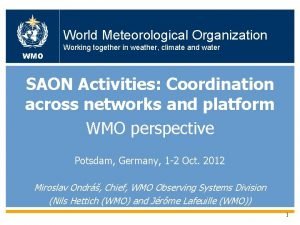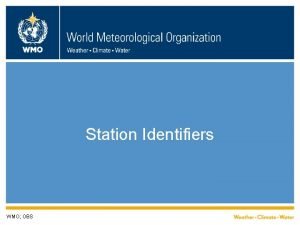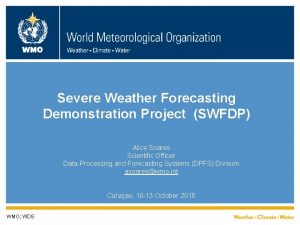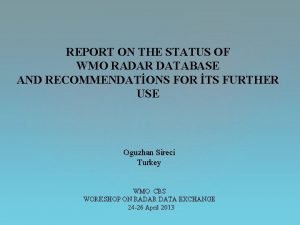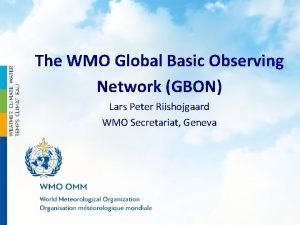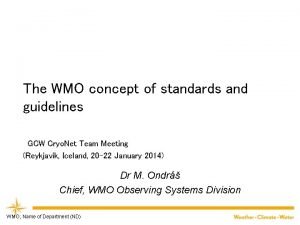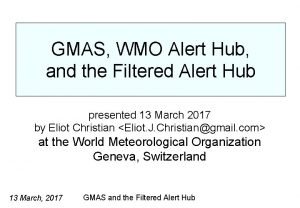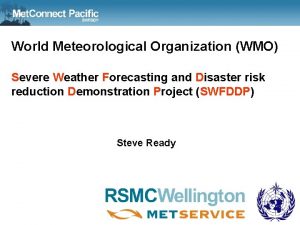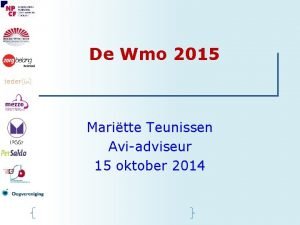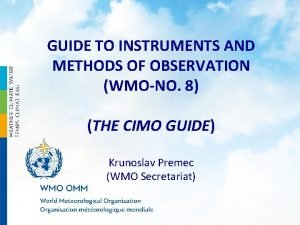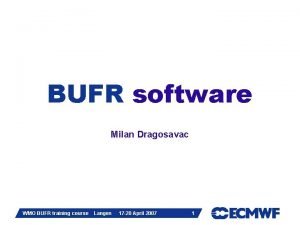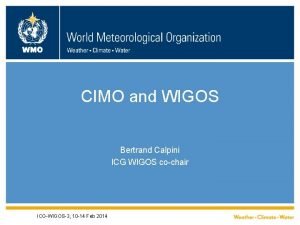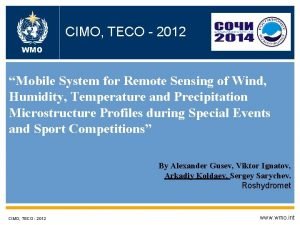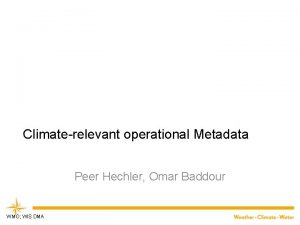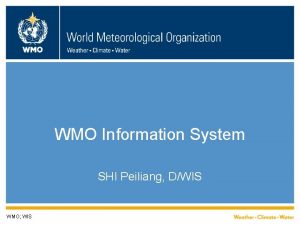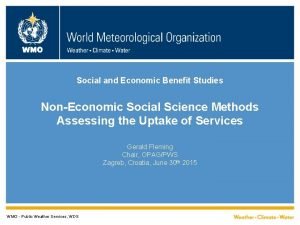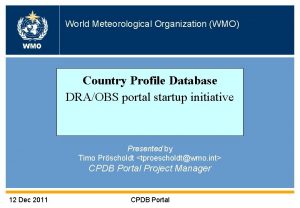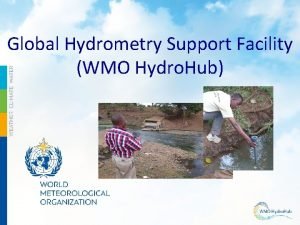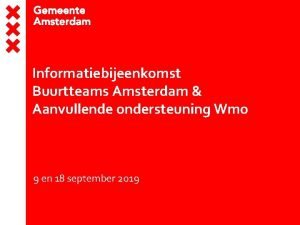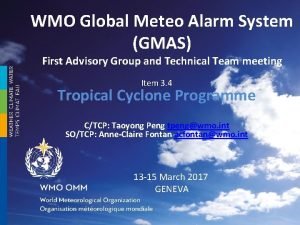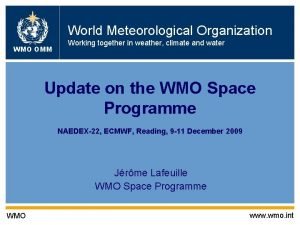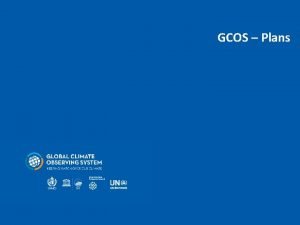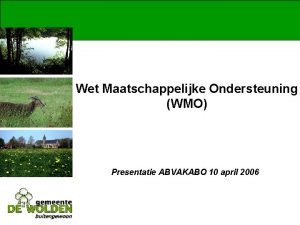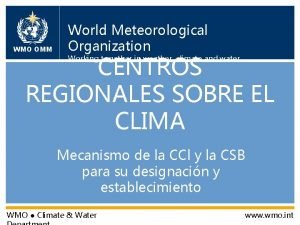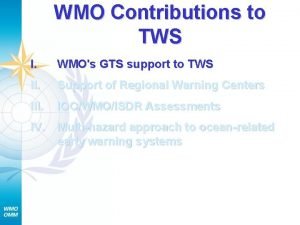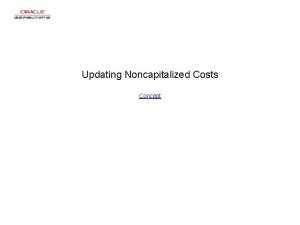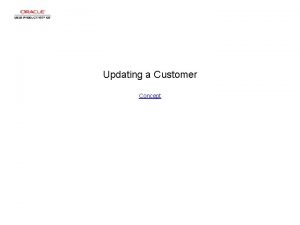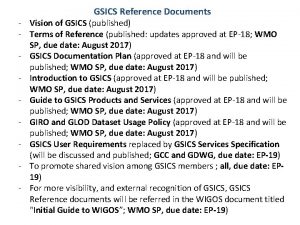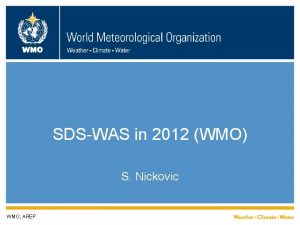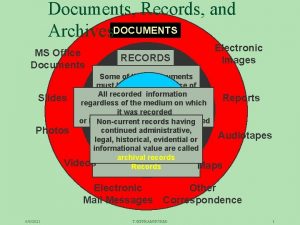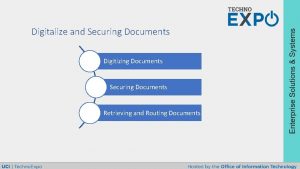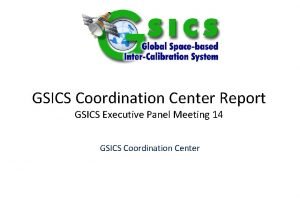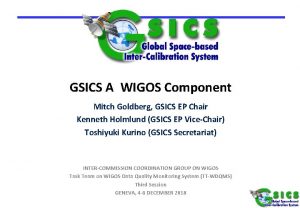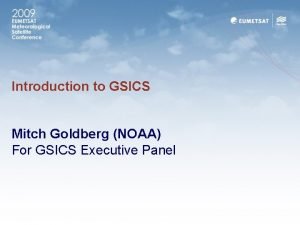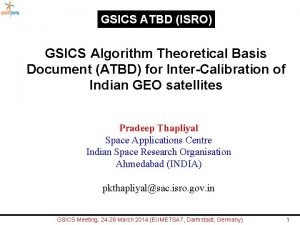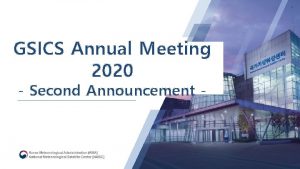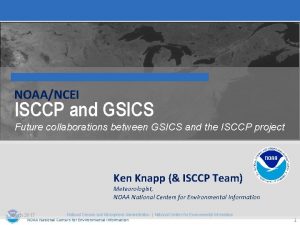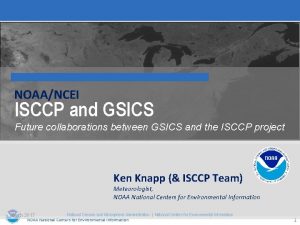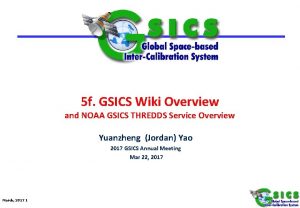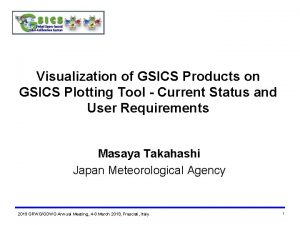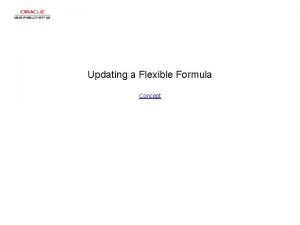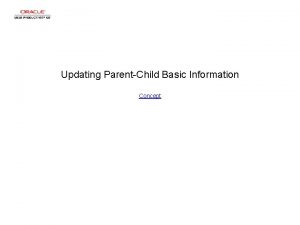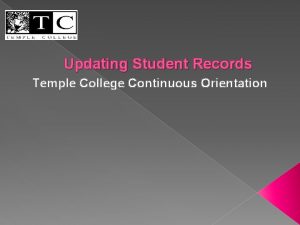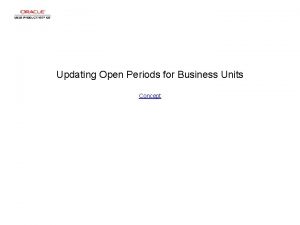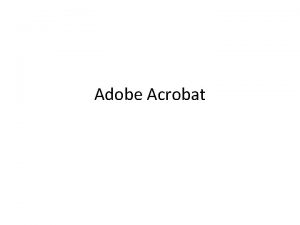UPDATING WMO DOCUMENTS RELATED TO GSICS WORKS IN











































- Slides: 43

UPDATING WMO DOCUMENTS RELATED TO GSICS WORKS IN PROGRESS THE CIMO GUIDE (WMO-NO. 8) THE GUIDE TO WIGOS (WMO-NO. 1156) AND FUTURE PROSPECTS WIGOS MANUAL (WMO-No. 1160) Toshiyuki Kurino (WMO Space Programme)

Contents: 1) 2) 3) 4) WMO Documentation CIMO Guide WIGOS Guide Future Roadmap for updating WMO Regulatory Documents to be reflected the GSICS activities on Space-based Inter -calibration: WIGOS Manual

WMO Documentation

WMO Documentation: Basic Documents Regulatory documents Technical Regulations Manuals Guides, guidelines, … Non - Regulatory documents

1. WMO Regulatory Documents Ø Basic Documents; Ø Technical Regulations; Ø Annexes to the Technical Regulations (Manuals); Ø Agreements and Working Arrangements with Other International Organizations.

Basic Documents q Convention q General Regulations q Staff Regulations q Financial Regulations q Agreements between the United Nations and the WMO q Convention of the Privileges and Immunities of the Special Agencies

Technical Regulations: q Volume I – General meteorological standards and recommended practices ; q Volume II – Meteorological service for international air navigation; q Volume III – Hydrology.

Purpose of the Technical Regulations (a) To facilitate cooperation in meteorology and hydrology among Members; (b) To meet, in the most effective manner, specific needs in the various fields of application of meteorology and operational hydrology in the international sphere; (c) To ensure adequate uniformity and standardization in the practices and procedures employed in achieving (a) and (b) above.

Annexes to the Technical Regulations I. International Cloud Atlas (WMO-No. 407) – Manual on the Observation of Clouds and Other Meteors; II. Manual on Codes (WMO-No. 306), Vol. I; III. Manual on the Global Telecommunication System (WMONo. 386); IV. Manual on the Global Data-Processing and Forecasting System (WMO-No. 485); V. Manual on the Global Observing System (WMO-No. 544), Vol. I; VI. Manual on Marine Meteorological Services (WMO-No. 558), Vol. I; VII. Manual on the WMO Information System (WMO-No. 1060); VIII. Manual on the WMO Integrated Global Observing System (WMONo. 1160).

The Technical Regulations comprise Ø standard practices and procedures (shall) - Members are required to follow or implement and inform the Secretary-General, of any change in the degree of their implementation; - have the status of requirements in a technical resolution. Ø recommended practices and procedures (should) - Members are urged to comply; - have the status of recommendations.

2. WMO Guides - practices, procedures and specifications; - Members are invited to follow or implement; - help in establishing and conducting arrangements for compliance with the To. Rs; - help in developing meteorological and hydrological services in Members’ respective countries.

The CIMO Guide: CIMO Guide - 1 st edition in 1954 (12 chapters); - guidance on the most effective practices for measurements and observations to achieve a standard quality; - practical advice on techniques which are well established and in regular use, from the simplest to the most complex and sophisticated; - authoritative reference for all matters related to instrumentation and methods of observation in the context of WIGOS.

CIMO Guide

2018 GUIDE TO METEOROLOGICAL INSTRUMENTS AND METHODS OF OBSERVATION (WMO-No. 8, CIMO Guide) GUIDE TO INSTRUMENTS AND METHODS OF OBSERVATION (WMO-No. 8, CIMO Guide) Part Title Vol. Title I MEASUREMENT OF METEOROLOGICAL VARIABLES II OBSERVING SYSTEMS II MEASUREMENT OF CRYOSPHERIC VARIABLES III SPACE-BASED OBSERVING SYSTEMS III OBSERVING SYSTEMS IV SPACE-BASED OBSERVING SYSTEMS V QUALITY ASSURANCE AND MANAGEMENT OF OBSERVING SYSTEM IV QUALITY ASSURANCE AND MANAGEMENT OF OBSERVING SYSTEM

CIMO Guide Vol I 1 2 3 4 5 6 7 8 9 10 11 12 13 14 15 16 MEASUREMENT OF METEOROLOGICAL VARIABLES General Measurement of temperature Measurement of atmospheric pressure Measurement of humidity Measurement of surface wind Measurement of precipitation Measurement of radiation Measurement of sunshine duration Measurement of visibility Measurement of evaporation Measurement of soil moisture Measurement of upper-air pressure, temperature, humidity Measurement of upper wind Observation of present and past weather; state of the ground Observation of clouds Measurement of atmospheric composition

CIMO Guide Vol II 1 2 3 4 5 6 7 8 MEASUREMENT OF CRYOSPHERIC VARIABLES General Measurement Measurement of of snow glacier and ice caps ice sheets ice shelves sea-ice lake and river ice permafrost and seasonally frozen ground

CIMO Guide Vol. III OBSERVING SYSTEMS 1 2 3 4 5 6 7 8 9 10 Measurements at automatic weather stations Measurements and observations at aeronautical meteorological stations Aircraft-based observations Marine observations Special profiling techniques for the boundary layer and the troposphere Electromagnetic methods of lightning detection Radar measurements Balloon techniques Urban observations Road meteorological measurements

CIMO Guide Vol. IV SPACE-BASED OBSERVING SYSTEMS Chapter Title 1 Introduction 2 Principles of Earth observation from space 3 Remote-sensing instruments 4 Satellite programmes 6 Space-based observation of geophysical variables Calibration and validation 7 Cross-cutting issues 5 P. No. 3 46 48 26 77 7 7 - Introduced in 2014 edition; - Before 2014: Part II/Chapter 8 – Satellite observations (36 pages).

CIMO Guide Vol V 1 2 3 4 5 QUALITY ASSURANCE AND MANAGEMENT OF OBSERVING SYSTEM Quality management Sampling meteorological variables Data reduction Testing, calibration and intercomparison Training of instrument specialists

CIMO Guide Part IV: SPACE-BASED OBSERVING SYSTEMS Chapter 6. Calibration and Validation 6. 1. INSTRUMENT CALIBRATION 6. 1. 1. Introduction 6. 1. 2. Factors affecting calibration 6. 1. 3. Pre-launch calibration 6. 1. 4. On-board calibration 6. 1. 5. Vicarious calibration 6. 1. 6. Intercalibration by simultaneous observations 6. 1. 7. Bias adjustment of long-term data records 6. 1. 8. Using calibration information 6. 1. 9. Traceability of space-based measurements 6. 2. VALIDATION 6. 2. 1. Validation strategies 6. 2. 2. Validation of Level-1 Data 6. 2. 3. Validation of Geophysical Products (Level-2) 6. 2. 4. Validation by Way of NWP REFERENCES AND FURTHER READING

WIGOS Guide

WIGOS Guide to WIGOS (WMO-No. 1156) (2017 edition; draft update 2018; for approval by EC-70) 3. 3. 7 Satellites For ensuring consistent accuracy among space-based observations from operational weather and environmental satellites of the Global Observing System (GOS) for climate monitoring, weather forecasting, and environmental applications, the Global Space-based Inter-Calibration System (GSICS), an international collaborative effort initiated in 2005 by WMO and the Coordination Group for Meteorological Satellites (CGMS), develops common methodologies and implements operational procedures to ensure quality and comparability of satellite measurements taken at different times and locations, by different instruments, operated by various satellite agencies.

WIGOS Guide Draft Guide to WIGOS (WMO-No. 1156) (2017 edition; draft update 2018; for approval by EC-70) 3. 3. 7 Satellites (cont. ) This is achieved through a comprehensive calibration strategy which involves: 1) monitoring instrument performances, 2) operational inter-calibration of satellite instruments, 3) tying the measurements to absolute references and standards, and 4) recalibration of archived data. The resulting inter-comparisons achieve inter-calibration when the measurements are traceable to absolute references and standards. GSICS contributes to the integration of satellite data within the WMO Integrated Global Observing Systems (WIGOS).

WIGOS Guide Draft Guide to WIGOS (WMO-No. 1156) (2017 edition; draft update 2018; for approval by EC-70) 3. 3. 7 Satellites (cont. ) Meteorological satellites usually transport a variety of instruments, each mounted for specific applications required by a diverse user community. In fact, due to this variety of instruments and the specific observation programme chosen, the related metadata have a different nature than with the classic surface-based observations (see the Guide to Instruments and Methods of Observation (WMO-No. 8)). As a consequence, metadata for satellite observations with calibration information are collected as a separate database, OSCAR/Space. Reference Guide to GSICS Products and Services

Future Roadmap (WIGOS Manual)

WIGOS Manual (WMO-No. 1160) (2015 edition; updated in 2017) 4. ATTRIBUTES SPECIFIC TO THE SPACE-BASED SUB-SYSTEM OF WIGOS 4. 1. Requirements 4. 2. Design, planning and evolution 4. 3. Instruments and Methods of Observation 4. 3. 1. Calibration and Traceability 4. 4. Space Segment Implementation 4. 5. Ground Segment Implementation 4. 6. Observational Metadata 4. 7. Quality Management 4. 8. Capacity Development

WIGOS Manual 4. 3. 1 Calibration and Traceability 4. 3. 1. 1 Satellite operators shall perform a detailed instrument characterization before launch. Note: Members must strive to follow the pre-launch instrument characterization guidelines recommended by the Global Spacebased Inter-calibration System. 4. 3. 1. 2 After launch, satellite operators shall calibrate all instruments on a routine basis against reference instruments or calibration targets. Note 1: Advantage should be taken of satellite collocation to perform on-orbit instrument inter-comparison and calibration. Note 2: Calibration must be done in accordance with established and documented methodologies by the Global Space-based Inter -Calibration System (GSICS) and the Committee on Earth Observation Satellites (CEOS) Working Group on Calibration and Validation.

WIGOS Manual 4. 3. 1. 3 Satellite operators shall ensure traceability to International Standards (SI) according to international approved standards. Note: The Implementation Plan for the Global Climate Observing System (WMO/TD-No. 1253) calls for sustained measurement of key variables from space traceable to reference standards, and recommends implementing and evaluating a satellite climate calibration mission. 4. 3. 1. 4 To ensure traceability to International Standards (SI), satellite operators shall define a range of ground-based reference targets for calibration purposes. 4. 7. Quality Management Satellite operators shall include appropriate quality indicators in the metadata for each dataset, in accordance with the provisions of section 2. 5.

GSICS-RD 000: GSICS Documentation Plan

Summary - GSICS to review the latest version of the WMO CIMO Guide Volume IV: SPACE-BASED OBSERVING SYSTEMS / “Chapter 6. Calibration and Validation” (deadline: 31 March 2019). - GSICS to accept the “Chapter 6” as a GSICS documentation for the “rolling review” for updating. - GSICS to review and update the GSICS high-level reference document “RD 003: Guide to GSICS Products and Services” which was referred in the Guide to WIGOS (deadline: August 2019). - GSICS to support reviewing of the WMO “Manual on WIGOS” for reflecting GSICS contribution to Calibration and Traceability Data Quality Monitoring of space-based observations.

Thank you Merci

GSICS Documentation The following kinds of GSICS documentation are maintained: • GSICS high-level reference documents submitted to Executive Panel approval, including. - RD 001: Introduction to GSICS - RD 002: Vision of GSICS - RD 003: Guide to GSICS Products and Services - RD 004: Terns of Reference of GCC, EP, GDWG and GRWG - RD 005: GSICS Service Specification - RD 006: GIRO and GLOD Dataset Usage Policy • GSICS organization documents and procedures • GSICS technical standards and best practices • Technical guides for GSICS services and tools • Technical guides for GSICS products • GSICS outreach and communication material In addition, the GCC keeps a record of: • Periodic GSICS publications (e. g. GSICS Quarterly) • Publications based on GSICS activities.

CIMO Guide GUIDELINES FOR DRAFTING UPDATES / NEW EDITIONS (1) - techniques that are well established and in regular use should be described; - methods that are recommended or in common use should appear first; - methods that are rare or whose use is discouraged should appear afterwards; - if a method is strongly preferred/obsolete, this should be stated clearly in the CIMO Guide;

CIMO Guide GUIDELINES FOR DRAFTING UPDATES / NEW EDITIONS (2) - advice on uncertainty, reliability and other aspects of performance, with comprehensive discussion of sources of error; - practical advice on aspects of observations and measurements; - an outline, and an introduction to the literature, for the well-informed non-specialist;

CIMO Guide GUIDELINES FOR DRAFTING UPDATES / NEW EDITIONS (3) - the level of technical detail and the content should be appropriate; - well-documented comparisons or evaluations of instruments; - national practices and observing networks, particular manufacturers or suppliers and/or their observing networks should be avoided;

CIMO Guide GUIDELINES FOR DRAFTING UPDATES / NEW EDITIONS (4) - headings in Vol II to V are much more flexible than in Vol I; - a structure of a new chapter drafted for Vol II to V, should be, as far as possible, consistent with the other chapters of a relevant Vol; - annexes can include almost anything that is inconvenient elsewhere in the text, e. g. formal statements; formulae, constants;

CIMO Guide GUIDELINES FOR DRAFTING UPDATES / NEW EDITIONS (5) - reporting practices should not be included in the CIMO Guide, but in the Manual on Codes (WMONo. 306); - the presentation of the material should follow the WMO Style Guide and the WMO Editorial checklist; - pictures may be included, but require obtaining written agreement of the copyright holders.

CIMO Guide GUIDELINES FOR DRAFTING UPDATES / NEW EDITIONS (6) Referencing: - WMO Manuals and other Guides and guidelines; - reviewed and readily available papers; - reports of conferences and in-house papers are often too transient or inaccessible to be very useful and should be used only if necessary and if no other material is available; - glossaries are not used.

CIMO Guide GUIDELINES FOR DRAFTING UPDATES / NEW EDITIONS (7) Terminology: Ø the International Meteorological Vocabulary (WMO-No. 182) http: //library. wmo. int/pmb_ged/wmo_1821992_en. pdf; Ø the International Vocabulary of Metrology – Basic and General Concepts and Associated Terms (VIM) http: //www. bipm. org/en/publications/guides/vim. html; Ø the Evaluation of measurement data – Guide to the expression of uncertainty in measurement (GUM), http: //www. bipm. org/en/publications/guides/gum. html.

CIMO Guide GUIDELINES FOR DRAFTING UPDATES / NEW EDITIONS (8) Ø Vol IV is primarily intended to tell those responsible for surface-based measurements what they can expect from space-based systems; Ø References and Further Reading appear at the end of the Vol rather than at the end of each Chapter; Ø To use "free troposphere" and "planetary boundary layer", instead of "upper" and "lower troposphere", respectively (as agreed within WMO RRR activities).

CIMO Guide PROCEDURES FOR UPDATING THE CIMO GUIDE Ø Updates/revisions of the Guide are initiated as soon as a sound proposal is submitted; Ø Proposals (apart from minor changes and typos) have to be included in track-change mode in the MS-Word file of the most recent version of the CIMO Guide.

CIMO Guide CIMO contributions Revised chapter developed by expert Review and approval by relevant ET Contributions by other TC / groups Revised chapter developed by expert Review and approval by relevant ET Review by CIMO authority CIMO Ed. Board Other TC President CIMO President Consultation of WMO Members – Nomination of FP in case of comments Final Approval by CIMO or CIMO President CIMO Ed. Board Posted on web repository

CIMO Guide For more details, please visit: https: //www. wmo. int/pages/prog/www /IMOP/CIMO-Guide. html https: //www. wmo. int/pages/prog/www /IMOP/publications/CIMOGuide/Prelim_2018_ed/Preliminary-2018 -edition. html
 Database commit is triggered by
Database commit is triggered by The updating of accounts is called the adjusting process.
The updating of accounts is called the adjusting process. Sccm cluster aware updating
Sccm cluster aware updating Mq concepts
Mq concepts 2 types of fitness
2 types of fitness Example of skill-related fitness
Example of skill-related fitness Safety at streetworks
Safety at streetworks Wmo global campus
Wmo global campus Cimo guide wmo
Cimo guide wmo Gdpfs wmo
Gdpfs wmo Gmas wmo
Gmas wmo Wigos
Wigos Wmo
Wmo Gbon wmo
Gbon wmo Wmo omm
Wmo omm Wmo omm
Wmo omm Wigos station identifier
Wigos station identifier Wmo severe weather
Wmo severe weather Ipcc wmo
Ipcc wmo Wmo radar database
Wmo radar database Gbon wmo
Gbon wmo Gcw guide
Gcw guide Alert hub
Alert hub Wmo severe weather
Wmo severe weather Wmo
Wmo Wmo-no. 8
Wmo-no. 8 Wmo bufr
Wmo bufr Bertrand calpini
Bertrand calpini Wmo cimo
Wmo cimo Omar baddour wmo
Omar baddour wmo Wmo wis
Wmo wis Ugly wmo
Ugly wmo Wmo cpdb
Wmo cpdb Wmo hub
Wmo hub Buurtteam amsterdam
Buurtteam amsterdam Wmo regional training centres
Wmo regional training centres Gmas
Gmas Wmo
Wmo Wmo strategic plan
Wmo strategic plan Wmo regional training centres
Wmo regional training centres Wmo omm
Wmo omm Wmo omm
Wmo omm Gts wmo
Gts wmo Wmo 1150
Wmo 1150
